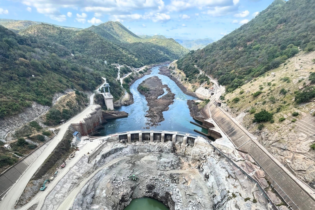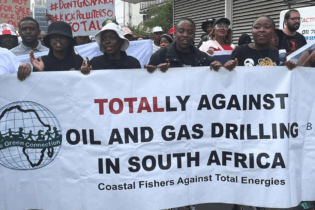Rail analyst John Batwell brings readers his recent interview…..
Transnet Freight Rail’s (TFR’s) CEO Siyabonga Gama is confidently upbeat about ‘the rebirth’ of South Africa’s railway system. This has been brought about by TFR unveiling its plans earlier this year to invest R206 billion in rail projects over the next seven years as part of a drive to treble revenues and support booming mineral exports. Of the R206bn, TFR will utilise R201bn, with engineering subsidiary Transnet Rail Engineering taking up R5bn. A R300bn Market Demand Strategy (MDS) aims to expand South Africa’s rail, port and pipeline capacity to generate a significant increase in freight volumes. Export coal traffic is expected to increase from 68 to 97,5 million tons by 2019, with iron-ore exports rising from 53 to 82,5 million tons. What favours Transnet even more fiscally at this point is the European and USA financial crisis. Gama says the turmoil in these overseas markets is presenting the likes of Transnet to procure assets in these regions cheaply. For example, an extended locomotive procurement programme planned by TFR could benefit from low interest rates from distressed overseas manufacturers desperate for growth. The Market Demand Strategy means significant additional capacity will be required on the Sishen-Saldanha iron-ore line, while the newly-announced Swazi-link project will relieve the congested Richards Bay coal corridor by providing an alternative route for general freight between Ermelo and the port of Richard’s Bay, which is expanding rapidly to meet demand. Asked about why the Swaziland link was needed over and above the existing coal corridor within South Africa’s borders, Gama said it was going to be an essential “bypass route” in the event of derailments on the coal line and furthermore every third train on the corridor is a non-coal train. With two million tonnes of coal moving per week on the corridor the non-coal traffic needed essentially to be re-routed. Considerable mineral traffic emanating from the Steelpoort area also endorsed the need for another rail artery to Richard’s Bay. The TFR CEO believes that the Coal of Africa mining projects in Limpopo province will more than likely not utilize the route through Swaziland, but with a Grindrod connection rather support the Matola terminal in Mozambique exclusively. The first test shipment of thermal coal from Coal of Africa’s Vele Colliery in the province did head out to Matola this past April. On the question of the government of Mozambique expressing concern at the road export volumes from South Africa to Maputo opposed to far greater rail usage, Siyabonga Gama stated that the reality is the constraints of Maputo harbour including the safety of the route. Some 15m – 20m tons of traffic do use this eastbound corridor to the Indian Ocean. Customer requests also dictate the use of particular destinations and there are also the user-friendly conditions of different ports. Transnet Freight Rail has already received kudos from mining giants Anglo American, BHP Billiton, and Kumba for improvements made over the last year. During one week in March 2012, TFR carried 2,2 million tons of iron-ore on the Sishen-Saldanha line, where three years ago it struggled to achieve weekly volumes of 1 million tons. An innovation latterly was the movement of iron ore in containers to the port of Saldanha. Asked if manganese would also go out through Saldanha, Gama was emphatic that these exports would be directed solely through the Eastern Cape port of Ngqura. Manganese export volumes are envisaged to catapult from the current 5,5m tons a year to 12mtpa by 2016/7. Of the R300bn MDS, R33bn was earmarked for the expansion and improvement of Transnet Port Terminals (TPT’s) bulk and container terminals. On the issue of General Freight Business (GFB) Transnet foresees overall rail freight volumes increasing from 200 to 350 million tons by 2019, and in addition to substantial growth in mineral traffic, TFR projects the market share of intermodal traffic rising from 79% to 92% by the end of the decade. With R140bn capex, the GFB, says Gama, has the greatest opportunity for growth and market share. It is planned to grow this business from 13% to 30% over the next seven years. This is a complete turnaround from Maria Ramos’s era in Transnet when the mineral corridors ruled the day. Agricultural products, chrome and granite are just three commodities that Gama identified as definitely needing to be moved by rail. Rail costs are 60% cheaper than by road. As far as getting product out of railway yards to the customers’ door expeditiously, Siyabonga Gama said that a numbering of trucking companies are now customers of Transnet and are striving for what he called ‘terminal efficiency’ – movement of goods over ‘the last mile’ to their destination. Specific commodity business units have been created within TFR to replace a regions-based operating business model.A success story for Transnet Freight Rail is its Johannesburg-Durban route, called Natcor (Natal Corridor). TFR has 34% of the market share on Natcor where it once held as little as 15%. There are 55 trains daily -22 container trains and all of Toyota’s motor vehicles are now moved by rail only. Port access to markets’ maritime connectivity is a strategic issue – South Africa’s ports outperform coastal SADC countries by far in terms of this ‘connectivity’. The Georgia Institute of Technology found Durban harbour far better globally connected than other ports in SADC. Asked about the Johannesburg-Cape Town corridor, Gama stated that there have been problems with this artery. Flooding in the Kamfersdam area near Kimberley has been a problem that requires technical addressing. Otherwise, this route lends itself well to fast-moving consumer goods, a market that still needs attention for corridor growth.
The MDS allocates TFR R78bn over the next seven years for new locomotives. Around half of this amount is to be spent with local suppliers. Siyabonga Gama said that 1 370 locomotives were to be procured to replace old and time-expired motive power. Besides the current erection of the environment-friendly General Electric class 43 locomotives in Transnet Rail Engineering’s workshops in Koedoespoort, Pretoria, a tender was imminent for 600 new electric units, 102 coal corridor-specific locos and and an additional 465 diesels. Six to seven manufacturers had expressed interest in the electric units’ tender and the diesel procurement programme had interested the overseas faithfuls, General Electric and EMD. Such tender awards took cognizance of local supplier contributions. Gama said he would like to see traction motors and engines themselves being made in South Africa. Bogies are produced by SCAW Metals, a black-empowered company, and the skills’ capacity is showing dramatic escalation. The General Electric C30ACi model locos on the assembly floor currently have 37% local content. Regards the apparent tardiness related to the issue of branch line concessioning, Gama acknowledged that little had been said publicly since the initial Expressions of Interest (EOIs). Three branches have been firmed up, but he said one has to tread very carefully with such concessions. Transnet Freight Rail does not want to be party to what he called “30-day wonders” , where concessionaires come in blazing and go bust in no time at all. He acknowledged that such concessions would precipitate job creation and opportunities for people in the relevant areas. Transnet Freight Rail expertise would still be required and things like motive power and rolling stock refurbishment. Asked about other rail operators being given access to Transnet’s railway lines to move product off a branch line to a destination that embraced movement over the parastatal’s tracks, Siyabonga Gama stated that this issue of “access” was on the cards but had to meet the stringent demands of the Rail Safety Regulator (RSR) as well. The issue of rail tourism was addressed and the fact that from the presidency down there is a demand for tourism in South Africa to contribute far more to GDP. Gama humorously commented that the world-renowned, award-winning Blue Train was still in the Transnet camp and was not going to be moved across to the Passenger Rail Agency of South Africa (PRASA). Through the implementation of the MDS, Transnet expects revenues to increase from R46bn to R128bn by 2019. Besides the ‘bells and whistles’ of new hardware and growing markets, Siyabonga Gama acknowledged that a huge challenge has existed on the human resources front. With 34 000 employees it has not been easy to change the ‘mind-set’ of people to move out of the 9 – 5 mentality, that characterises so many government-oriented businesses, to buy into the Market Demand Strategy. It is taking training but Gama was happy that the mentality was already far better than five years back. As he said himself, the organisation is witnessing ‘a new snake’ moving from its old skin. A talent nurturing programme is already in place. Crime is a huge problem afflicting the likes of Transnet Freight Rail – Transnet security head Rodney Toka has stated publicly that there were 6 917 incidents of cable theft on the railway in the past three years. The nominal value of the stolen wire was some R95,5m but it cost R239m to replace. These figures took no account of the cost of train delays caused by the ‘theft plague’. Siyabonga Gama agreed that over distances greater than 500km, rail transport becomes more economical than road for general freight and as a large percentage of the rail system is electrified, increased movement of traffic by rail would reduce the economy’s reliance on liquid fuels and oil imports. Furthermore, the latest batch of 143 diesel locomotives being built for TFR are technically designed to reduce emissions by 1 500 tons of carbon dioxide per annum. A final comment comes from the University of Stellenbosch’s supply chain management centre head Dr Jan Havenga – high density lines should be run as effective businesses while the low density lines should be run as development businesses. A definite solution to mitigating the risk associated with transport costs, such as the uncertainty of fuel pricing for example, is a significant modal shift from road to rail.






